
Beading Our Way Home: Youth Photo-Voice Project
This exhibit was presented at Métis Family Services on Tuesday April 25, 2023.
Call to Witness
Children play an important role within a Métis worldview. Children come from Spirit and come into people’s lives because they have something to teach them. The youth in this project have something to teach you.
As a witness, you also play an important role. Please reflect on and share what you have learned.
- What did this exhibit make me think about?
- What did it make me feel?
- What does it make me want to do?
*All of the names below are pseudonyms
Sarah – 13
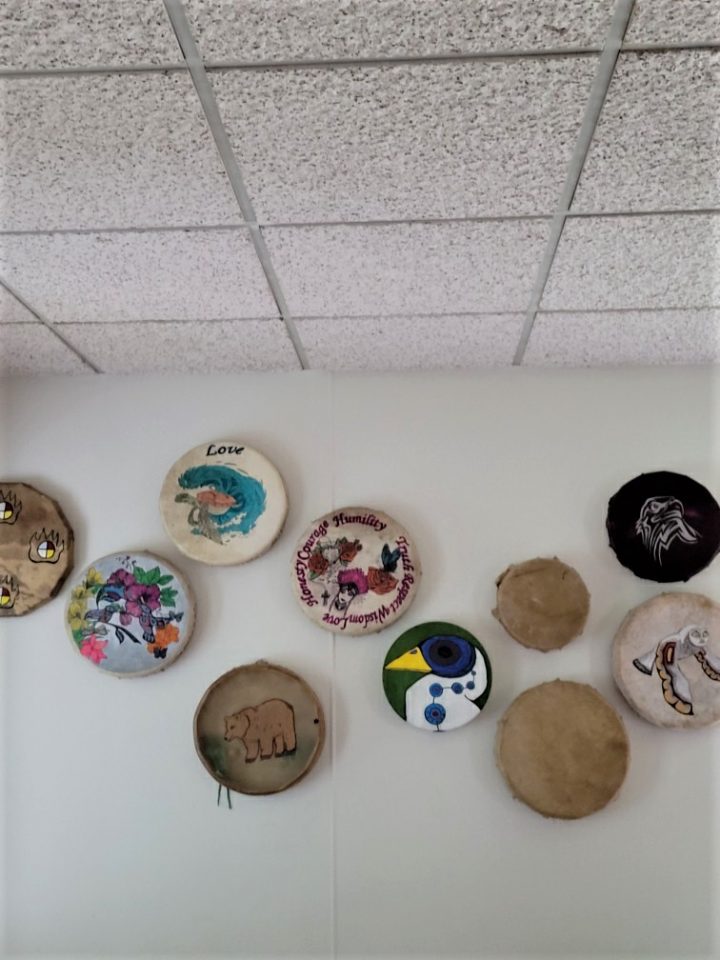
Drum Wall
All of those drums belong to different people in my family. Once we get a drum, we hang it up for everyone to see. The purple drum in the top right-hand corner, that one’s mine. I got it from my grandma’s friend who made it for me. It meant a lot. Those drums are really special to us. We’ll take them to gatherings; we’ll play them there. When I have drum group at school, I’ll take my drum sometimes. Makes the home feel a little more special. It feels like there’s good energy with them. Just knowing that every child who got a drum was gifted it for a reason. Most of those drums were gifted to children when they got adopted.
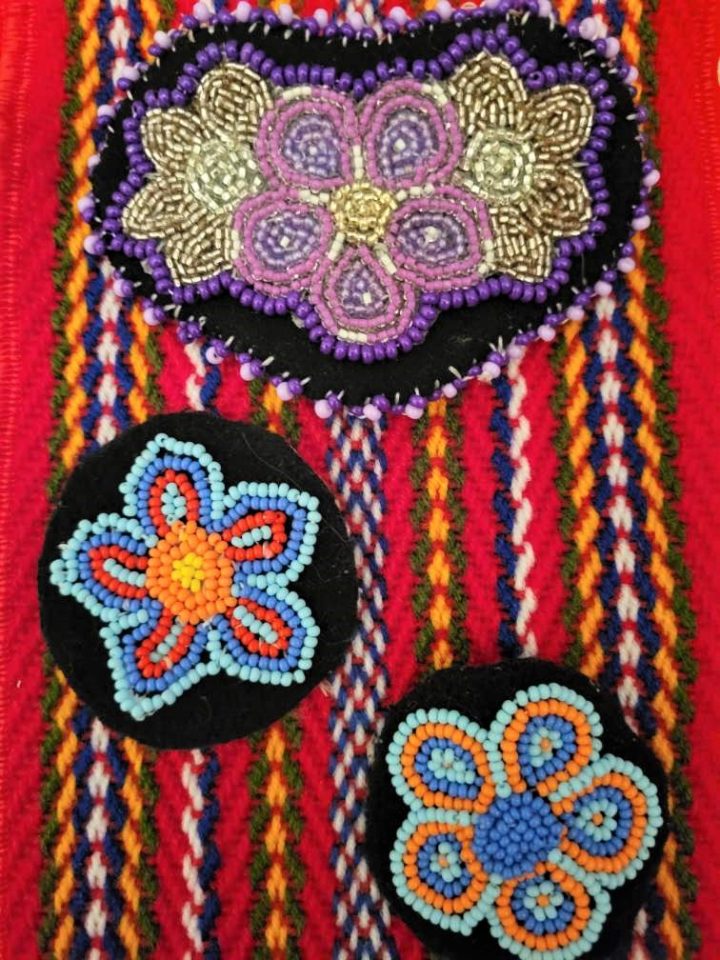
First Beadwork
The one with the orange and yellow center was the first one I did. The one with the rounded petals was the second one, and then the hair clip was the third. You can see my progress with it. It makes me feel really happy because I accomplished something really great, and I’m really happy with the work that I did. I put my beadwork on my Métis sash, it made sense, Métis flower beading, Métis sash. I was gifted it by social service guys a few months ago. It’s pride in my culture.

I took that because beading makes me feel really connected with nature. I enjoy doing it outside mostly because it’s really calming and cedar trees are a big part of Indigenous culture. It made me feel really happy and peaceful. I really like that cedar tree. It’s in my yard.
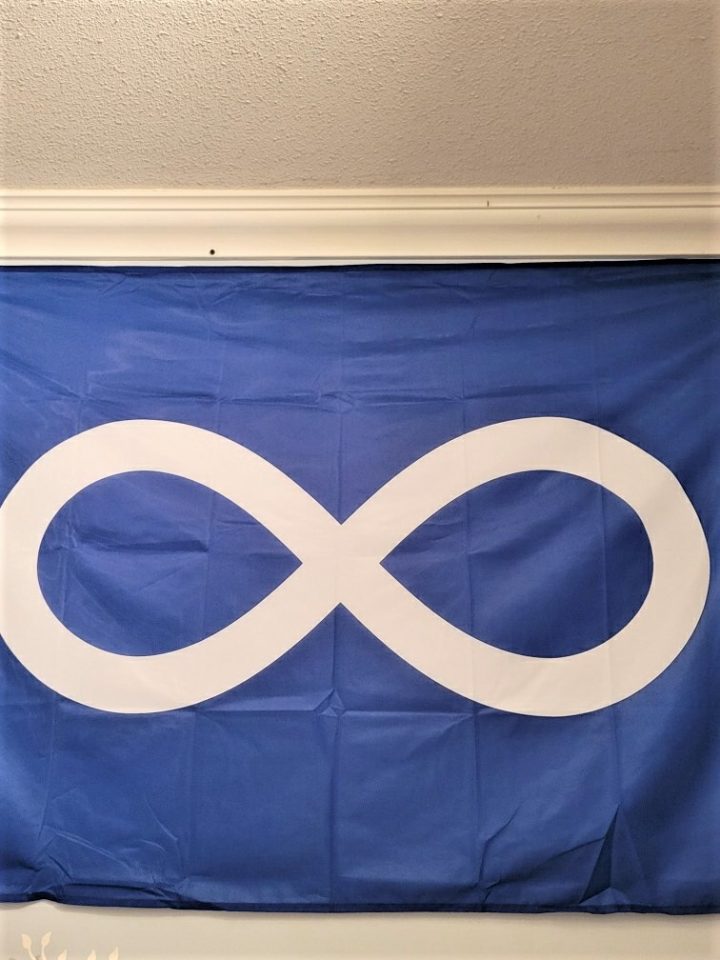
That Métis Flag, I was gifted it from family social services and it’s hanging in my room right now. It symbolizes my Métis culture, the infinity symbol. I really like that flag. It makes my room feel nicer, having that in there, adds some color too.
Corey – 9

Calmness

Amazing

I would say the beadworks, I like to do it. I learned that we Métis people are very good at art for sure. Also, that thing we worked on, so that was awesome, and it felt like I belonged into that culture. I felt like I was in the culture. I felt like I could do anything with that accomplishment.
Jessica – 17
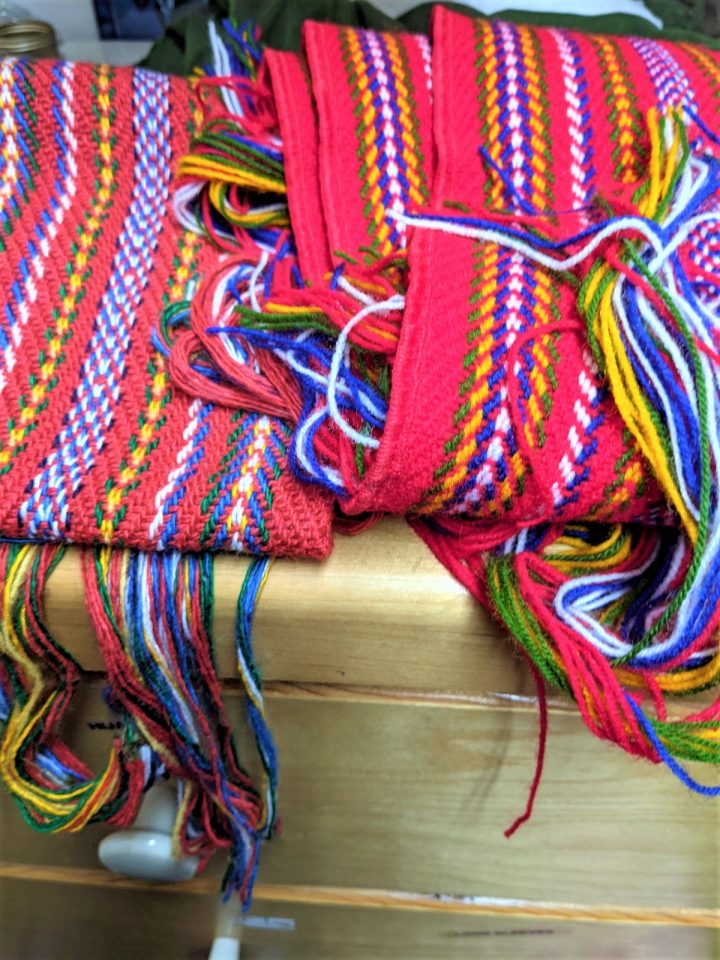
Honour
The sashes represent my heritage to my Métis culture. There’s two of them, the more faded one I had gotten while I was at a Métis retreat. The newer one, I had gotten it when I was honored with the Métis community for my work. I had done a lot of work in marginalized communities. When I’d originally gotten the sashes, I didn’t realize that it was all woven in. The striped design looked like they had been done in beadwork and I had originally thought that somebody had done them in beadwork.

Language
We were talking about Edmonton, and the French Michif vs. Northern Michif. I’d told Lisa I’d always wanted to learn some Cree and so she ended up helping teach some Cree and Michif. That’s her writing. We were talking and she wanted to write it out for me because I told her I’m way too slow at writing this out. It kind of helps me connect back with my Métis culture and understand at least simple words in Michif.

Progress
These one’s were kind of reminding me of what I learnt with Lisa and about beadwork. She drew what almost looks like peas in a pod and I drew the actual flower. For me, it kind of reminds me that I went from little rudimentary designs to actually beading a pair of pants.

Roots
The buffalo, you might not be able to notice but there are little pin pricks in it where I had done an ADHD friendly design and I wanted to beadwork that. I never got around to actually beading it. My plan is to finish the pin prick outline and then actually go in and bead it. It brings me back to a conversation I had on the difference between buffalo and bison. Whenever I look at it, I always think of that honouring ceremony and how that conversation came up. They said, “these are buffalo burgers”, and I said, “no these are bison burgers” and we ended up discussing the difference between a buffalo and a bison. It’s the front of an Indigenous magazine. With the buffalo, the title on the actual magazine is called “Roots”. The way that the buffalo is drawn, almost looks like it’s made out of leaves or something, like it’s made of nature.
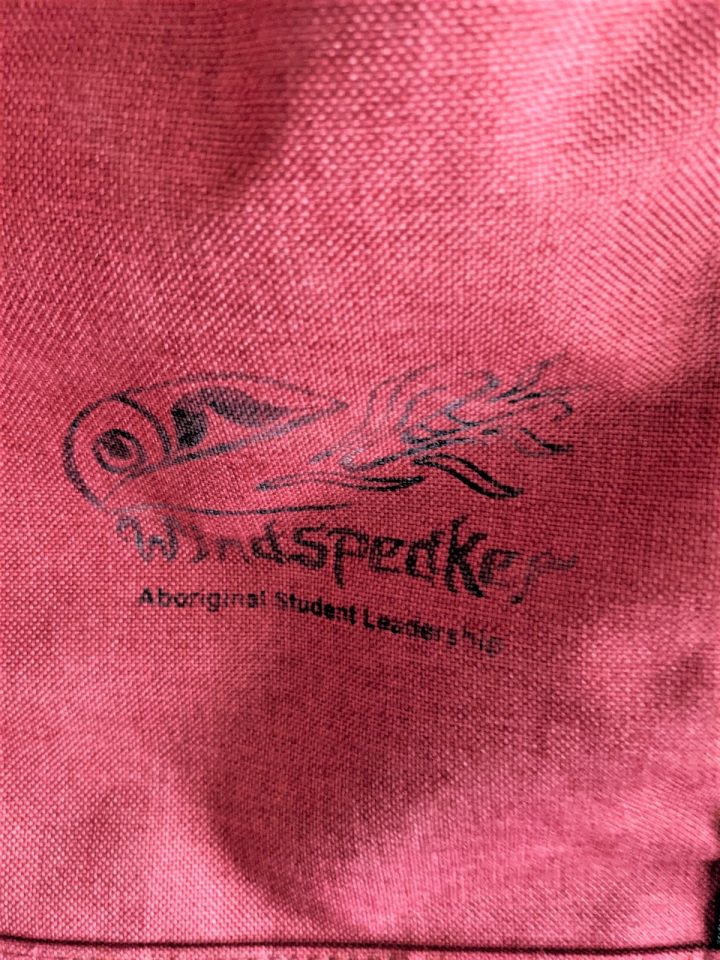
Windspeaker
That actually came off of a windspeaker bag that I went to. It was an Aboriginal youth leadership. The student youth leadership was something the Surrey School District ran through all our schools. I was involved from grade 9-12 with this program. I took the photo because I tried to do beadwork on it, but it turned out to be plastic on the inside, so it was really hard for me to puncture through it. The reason I took the photo was to show progress in my beadwork and how that was one of my first attempts on my own. There’s black beads going up the center of the fire. I did the beading with Lisa and then I brought this to Alberta with some of my other beadwork.
Cassie – 9
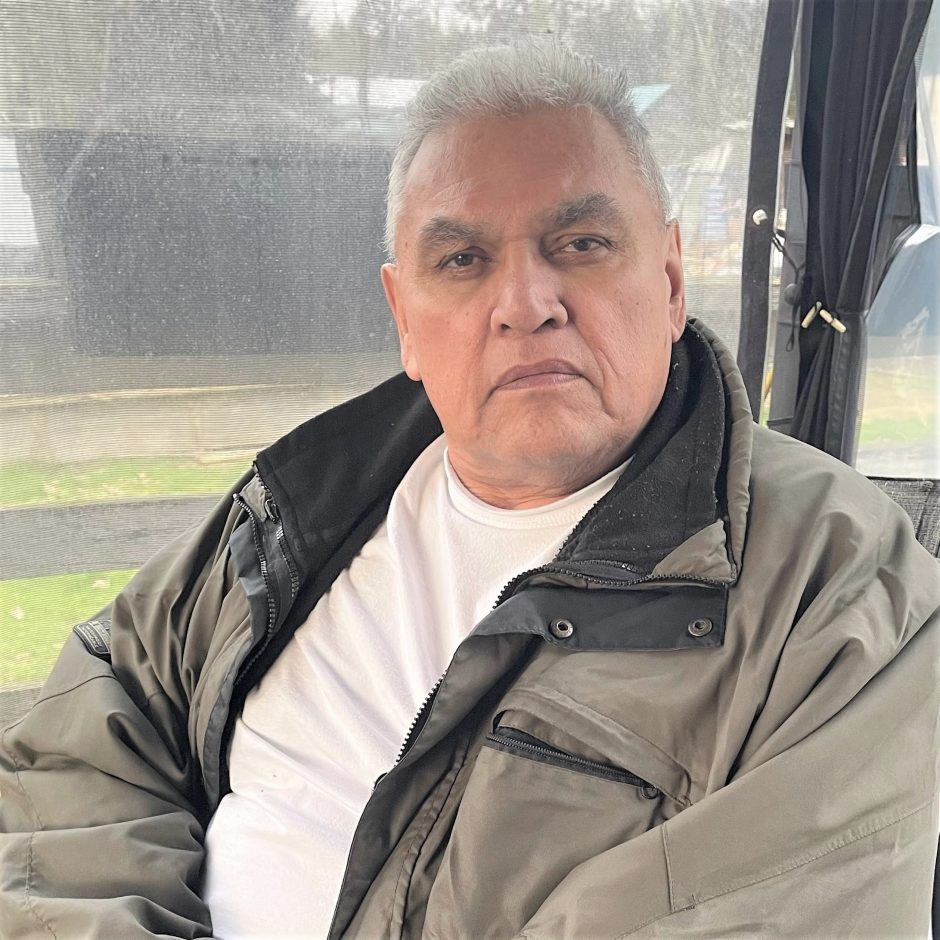
Cool Grandpa
My Grandpa really introduced me to a lot of things of my culture, and so he’s really helped me through the way. When I come back sad after like a day, he’s really supported me. He’s really helped me through the way, so has my grandma. My grandpa’s showing me the way to Aboriginal and Métis culture. I call him grandfather. It feels special to take pictures of them so I can show people how they inspired me and how they showed me the way.

Colorful Necklace
My dad made that. The blue represents water. The yellow represents sun. The red represents fire, and the white represents air. I took it because my dad really inspired me to start beading, but I didn’t really know how. It reminds me of my dad, and it reminds me of my culture. I wear it as a necklace. My dad’s really helpful and he supports me in a lot of stuff like my singing and all my hobbies. When I can’t do something and I’m like, “no, this is too hard”, he’s like, “no, keep on going. You can do it.” He’s always cheering me on every time I fall down.
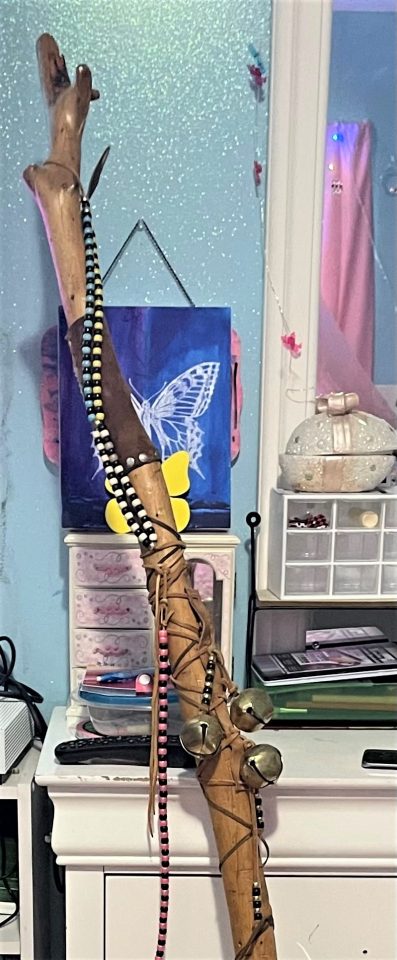
Beach Stick
It’s my grandfathers walking stick. He made it himself. It’s Aboriginal culture and he really wanted me to show the things that inspired me. He found it on a beach, and it took him a few days to make it. He picked the colors, and he beaded it. And this part it’s animal skin and you put nails into it to keep that animal skin intact. He wrapped this around so he could keep these beads down and he found a few bells in the garbage. My grandma threw them away because she thought she didn’t need them, and my grandpa used them. My grandpa uses it to walk. It means a lot to me because he let me use it. It really reminds me of my culture because when I usually think of my culture, I think of animals, I think of beads, I think of lots of homemade materials.

Skipping Dolly
That’s my Aboriginal doll in my room, Isabelle. She’s really special to me. She represents my culture. She’s really connected to me. I looked it up and this doll she likes exploring. She likes showing off her culture and she likes a lot of adventuring and stuff. I got her from my aunt. I’ve had her for two years now. It brings up my culture. She’s holding a feather.
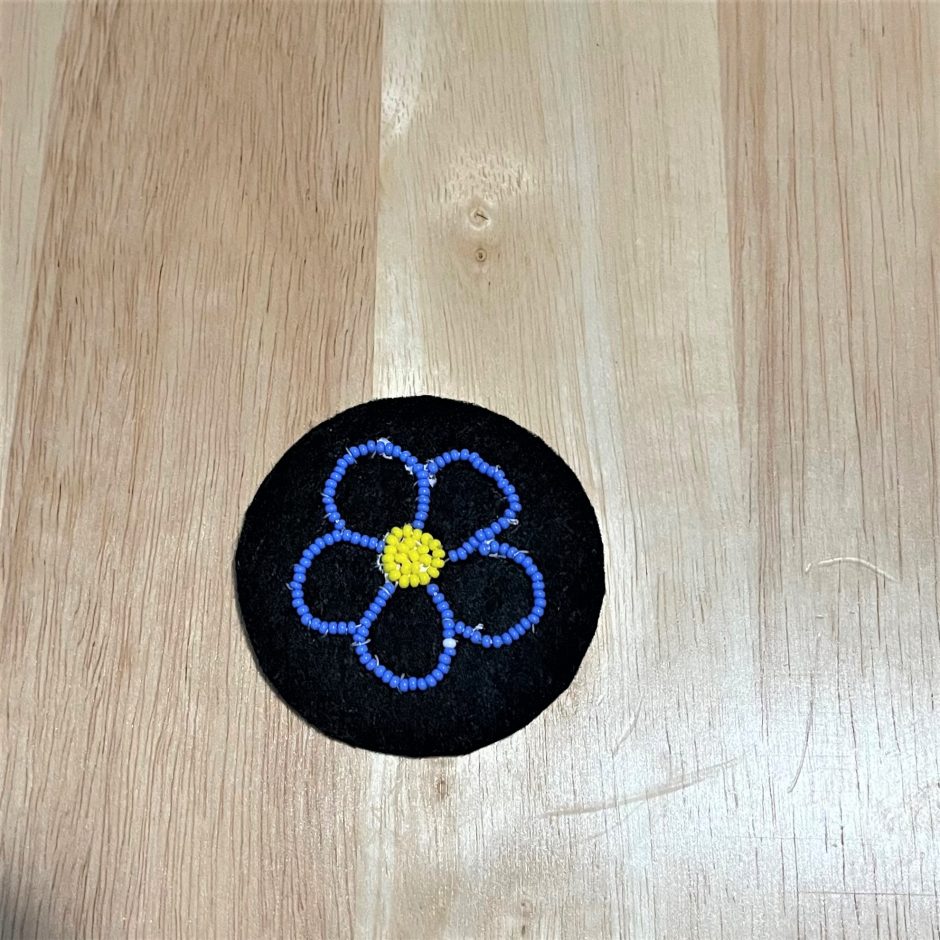
Beading Picture
It represents my culture and I like art. Lisa showed me how to do it and she kind of inspired me too. She inspired me to start beading, my dad and Lisa did that.

Dream Catcher
Usually when I go to my Kookum & Mooshum’s, we have dream catchers for the whole family and every night we sage it to make sure all the bad spirits are out of it. And since they don’t have sage at my house, I go outside, and I shake it to get all the bad spirits out. If they have a bad dream, it’s like a bad spirit getting into them. They use these to get all the bad spirits out of them every night, and to make sure they have a good life.
Cody – 15
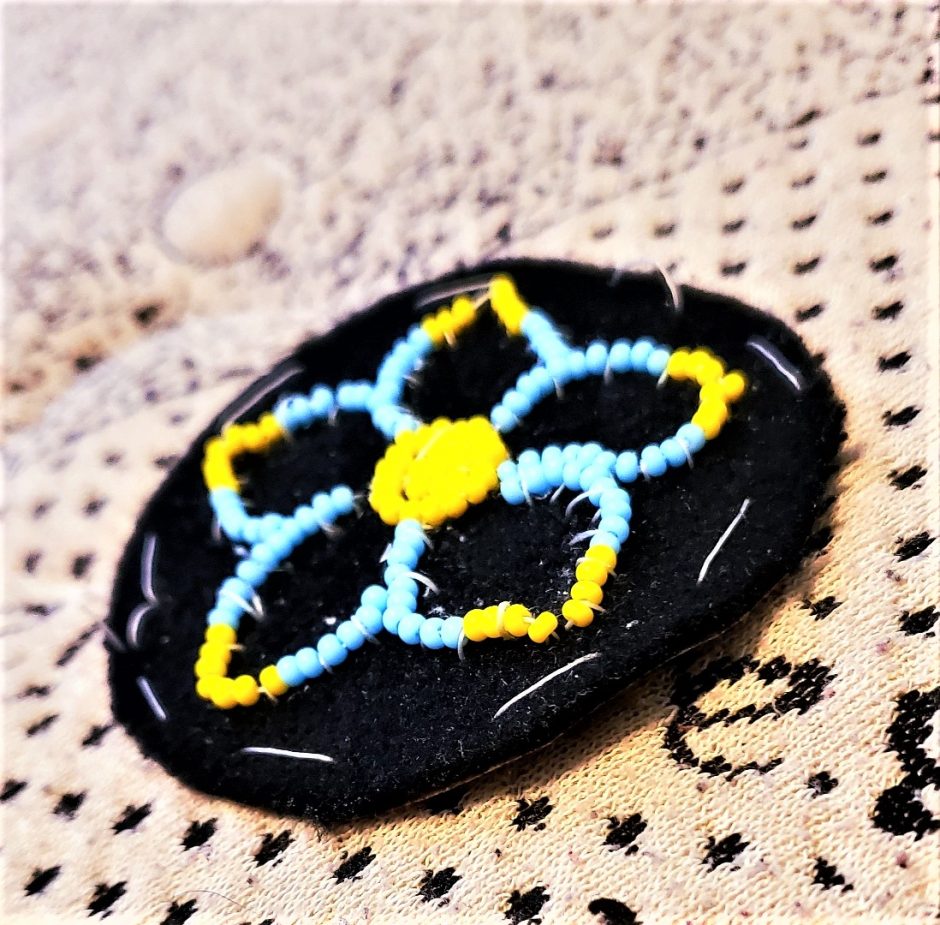
Memories
I liked the beading class a lot. I took the photo of the one that I did and I thought it turned out okay. It shows that I tried something that was in me, that I’ve never done before. It will remind me that this is something I’ve never done before, but it’s part of my culture. It’s something I can remember when I go on. Even if I lose the actual beadwork itself, I have a photo to show what I accomplished in it. When I look at it I remember the experience that I had there. It feels warm, something I wanted to learn, something that was, truly me. I’m gonna remember that even when I try and do more beadwork and that’s what I’m planning on doing.
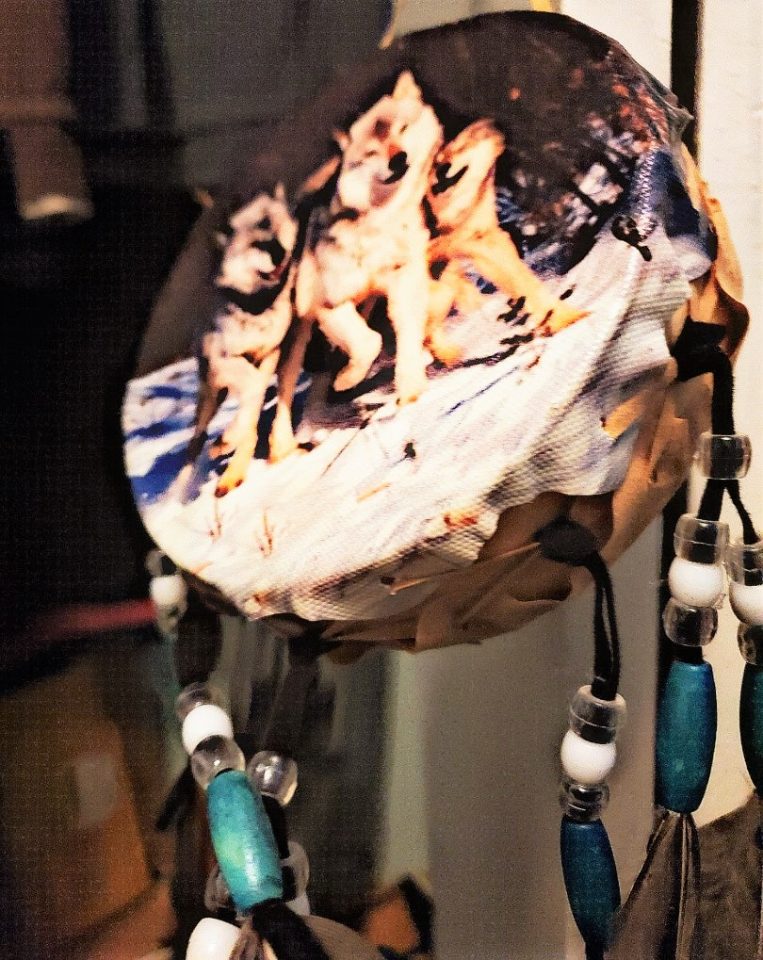
Dreams
Yeah, I have this dreamcatcher hung up on my closet that means quite a lot to me. It was a gift to me. It’s something that I can look at whenever I need to think of something that’s Métis related. Before I did beadwork, if I wanted to think of something Métis this would probably be my first choice. It shows that dreams can be good. It’s kind of the biggest thing in my room for dream related things. It’s meant to stop the worst dreams I guess and help with the better dreams.

Specialty
I took a photo of all the beading stuff that I had. It’s kind of the biggest beading Métis thing I’ve ever done because it’s never been something I’ve looked into really. It means me. It means what it means to me for Métis like it means me. It shows the good time I’ve had working on the bead stuff with Lisa and going out to learn about beading and it’s something that I’m going to try and keep because it means a lot to me. I’d call it specialty. It’s something that is really special to me.
Justin – 13

Beadwork
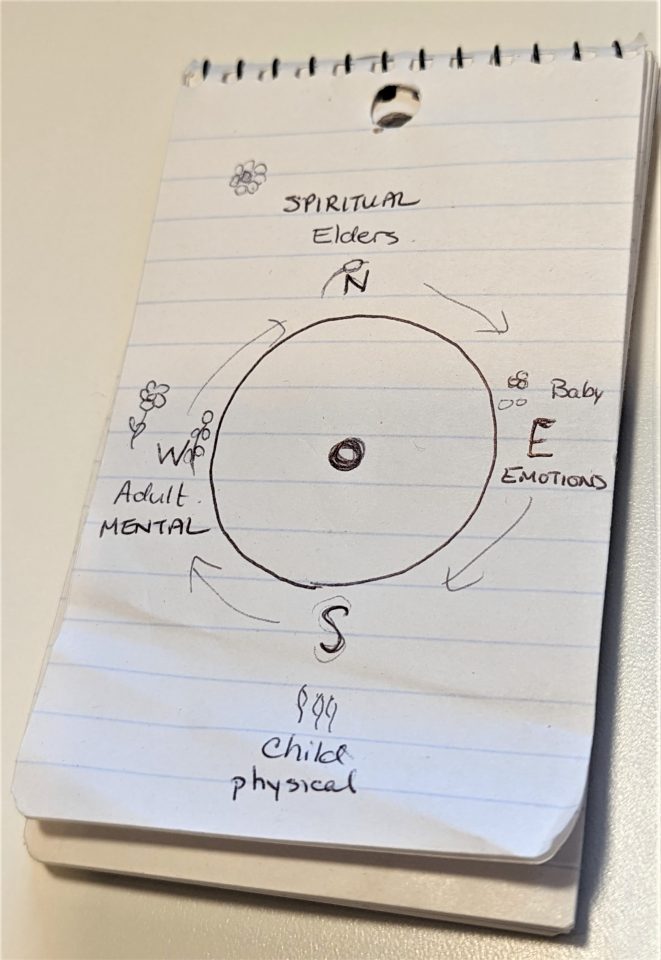
The Circle of Life
This circle of life and how you need every single sort of basic element of life to live. This is where she wrote how there’s a connection with everything of evolution and how it all goes in the circle. Babies represent emotions because they cry and stuff like that. Child is physical because they’re active. Adult is mental and then Elders are spiritual. So, when the elders they have babies, and they go into the baby phase. Babies grow up, become child and the child grow up into adults and then it keeps going in a circle and so the emotions, physical, mental, elders. She’s telling me about how if one thing in this, if your elders are wrong or if your spiritual is not good, then everything goes wrong. So you have to keep them all in a circle rolling straight. I thought it was pretty cool.

The Crest
This one is of it on my jacket. I mean, like, you’re rewarding yourself. I put it there because that’s where I’m gonna put it close to my heart. I used to do Taekwondo and there would be like a crest near your heart.
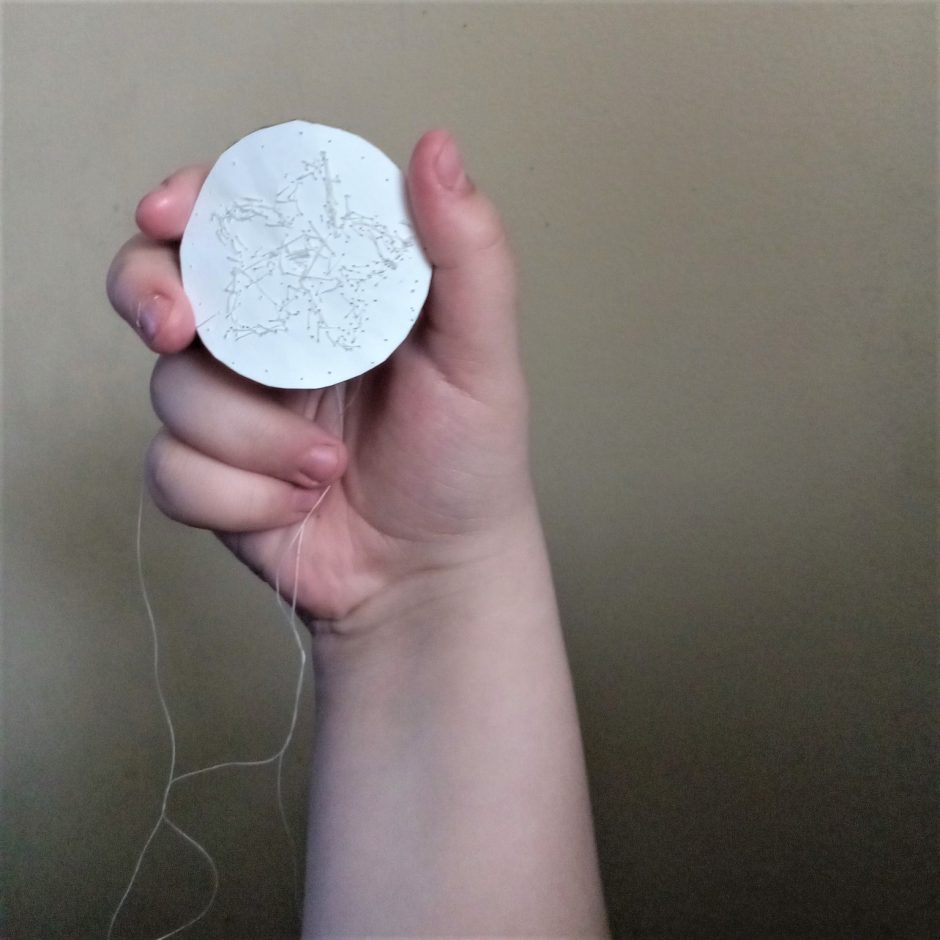
Imperfect
There’s the back of my beadwork. Lisa, she was telling me how it’s gonna look awful on the back, but on the front, it’s gonna look so good. I just thought it would be cool to take a picture of the back to see how there’s an ugly part of everything beautiful. I guess it symbolizes nothing’s perfect.
Evelyn – 16

Fancy
It means I’m Métis. It’s a flower and another flower. The big flower is for my mom, and I made the bag for my brother. It means I did a good job!
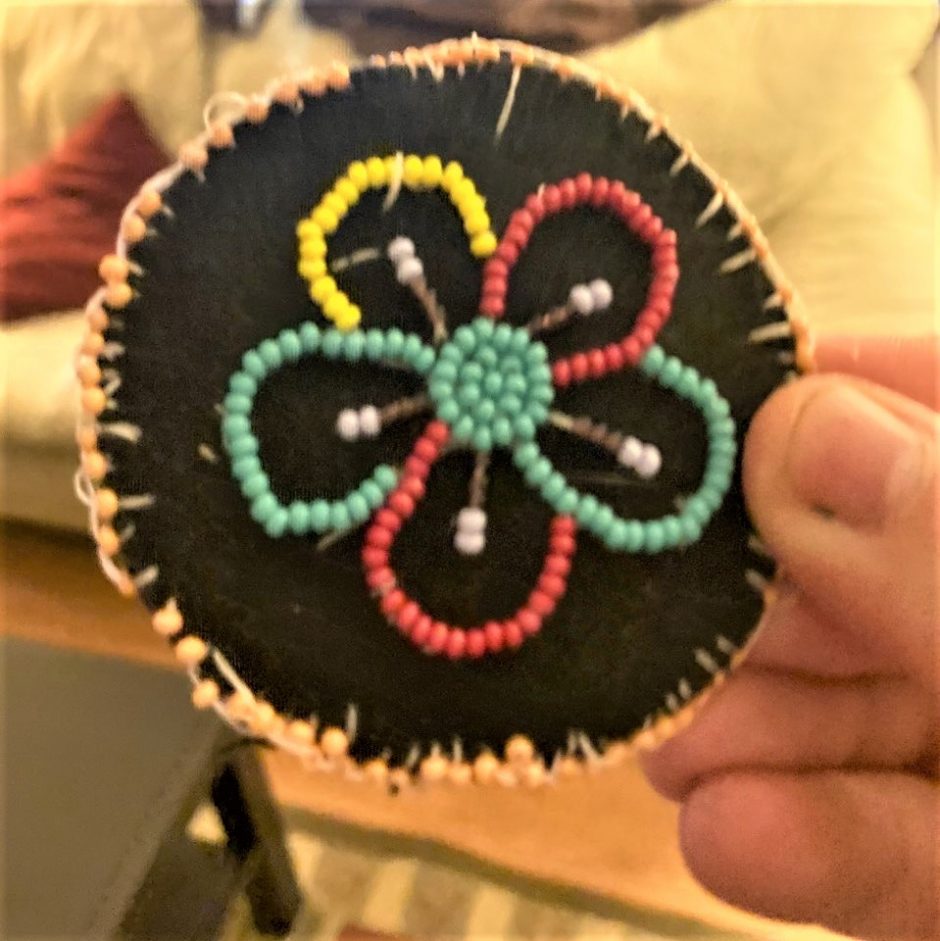
It’s Gorgeous and it’s for my Mom!
I put all my good luck in there for my mom. I’m going to put it on her blanket at school. I have a blanket that I am making her. It’s like you have to make knots. It’s a quilt.

Cool and Gentle
It means, that one’s chill. You can do anything, you’re chill. It’s cool and gentle because it’s a sage bag. It’s cool and gentle cause it helps you.
Gabe – 10

The Boat
I chose the canoe because they used to build canoes out of big logs of trees. They used to make them and take them to the sea and use them for many other things. I really like my boat and I got to build it. I’m pretty sure it was cedar.
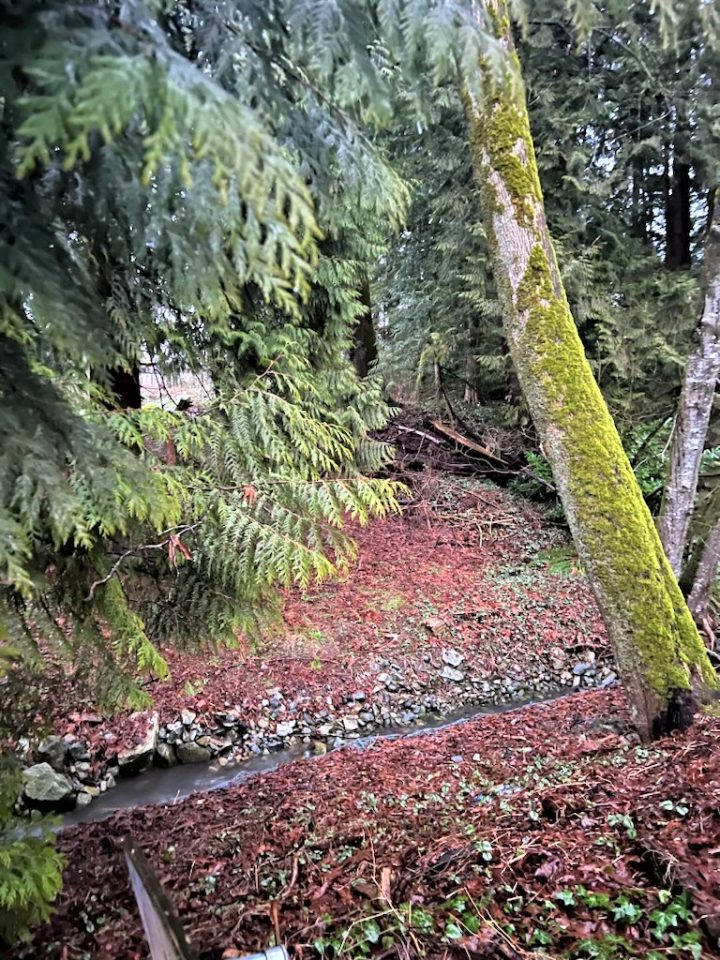
Nature
We are connected to the land. It makes me feel happy when I go to the forest. It’s right inside my backyard, the Serpentine River. I really like nature and being around nature makes me feel happy.
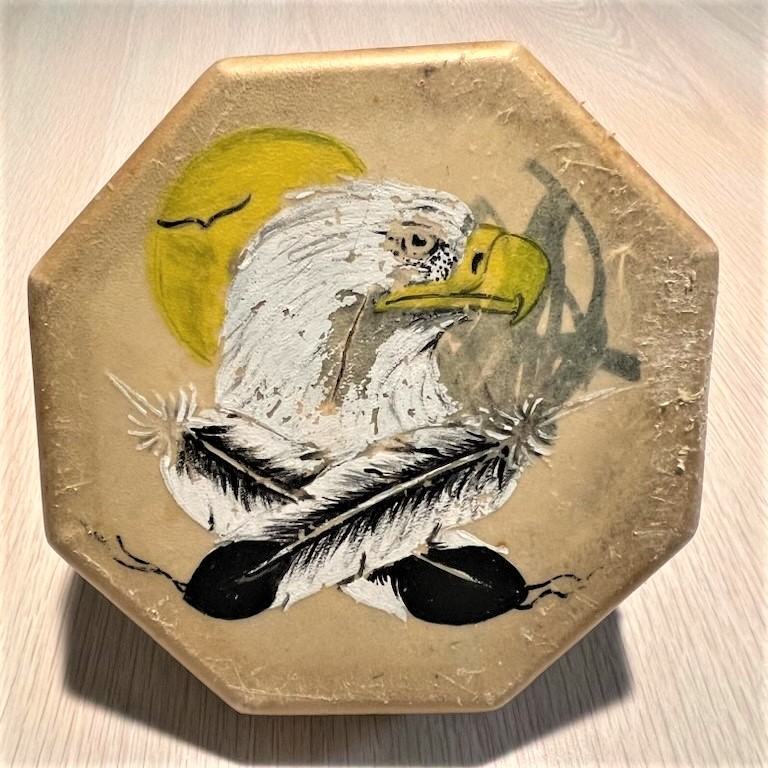
The Eagles Drum
I chose the drum because many Indigenous people would use it to do drumming. It’s from my grandpa. It’s not mine, but it’s my mom’s. It means that we use all the resources that we have.
Amy – 12
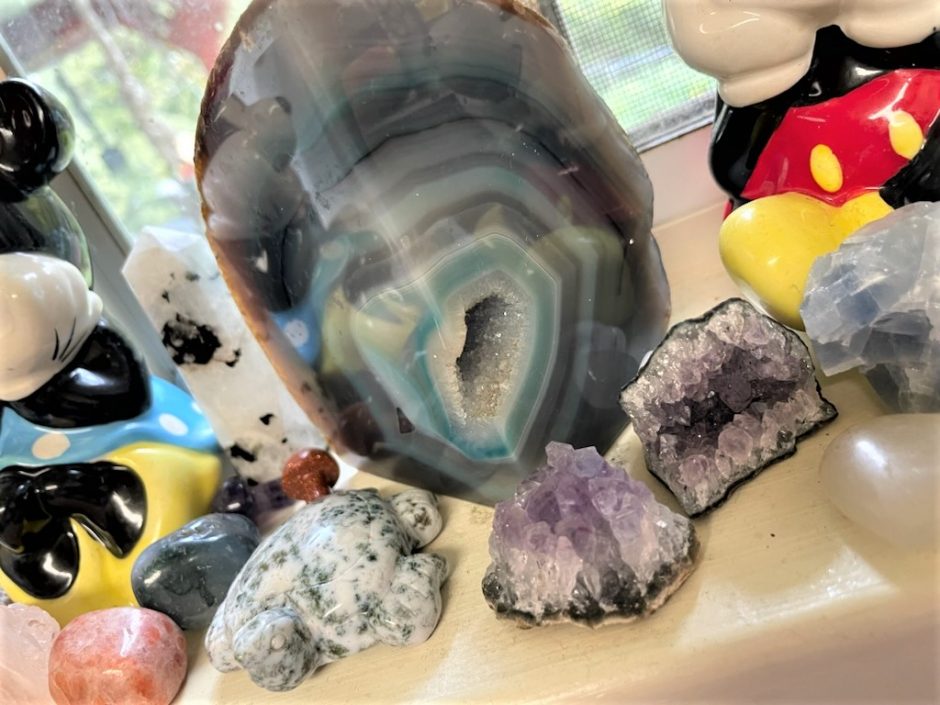
The Unique Powers of Crystals
Crystals mean power and they all have different powers. Lots of people are unique in their own ways and they all have different strengths, their powers. It shows people about power and different powers. The unique powers of crystals. (When beading) I was kind of showing power. )

The Smart Raven
I think Raven means smart because they’re kind of smart. They’re smart birds and sometimes with beadwork you have to be smart. We went to science world and then I saw that one and I really wanted that one and my mom said put it on my clarinet.

The Strong Feather
I took that one because you need strength through beading and feathers also mean strength. I choose the feather because it shows strength. The strong feather.

Pretty Butterflies
That was my Nana’s. This is in the kitchen. Butterflies and flowers are really pretty and when you’re beadwork is done, it’s really pretty. So, it kind of reminded me of butterflies and flowers.
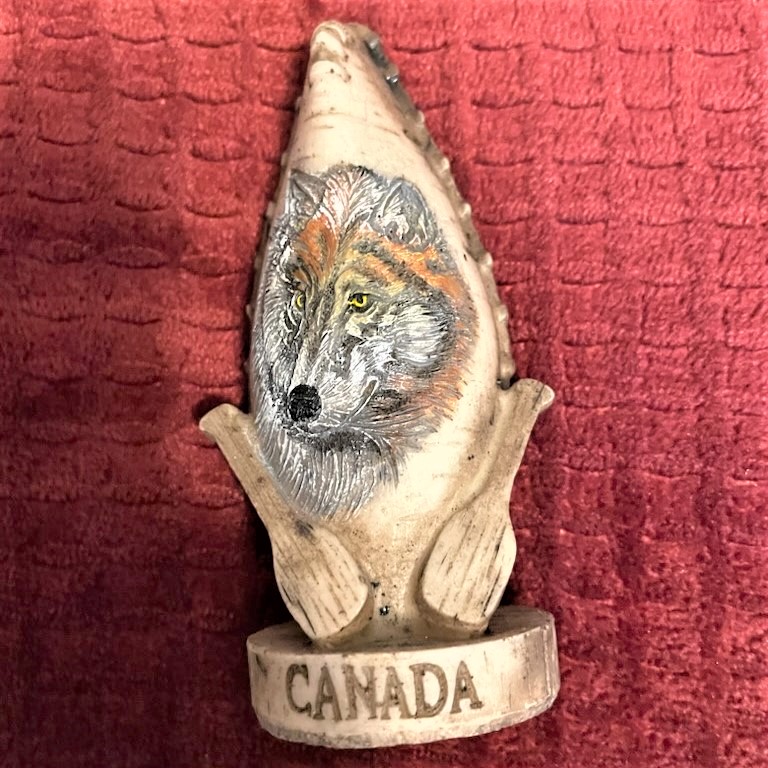
The Canoe Pack
I took a picture of that one, it also is a canoe. Sometimes when you’re doing beading, sometimes you could be in packs and work good together.

Wooden Carving
I think it’s a Bear. I was thinking of a bear because it could be a spirit animal and you kind of need good hands to do beading. Like, if you’re not really steady, sometimes it won’t look as good.

The Salmon
That’s a fish. I took that one because it’s a box that my grandpa carved. My grandpa is Métis, and he carves a lot of stuff like that. So, the beading kind of reminded me of that.
Emerging Themes
There were twelve emerging themes from the participants’ interviews and photographs which represent different aspects of connection and relationships, personal growth and self-awareness, and health and well-being.

Theme 1: Cultural Identity & Connection to Culture
The beading sessions provided a place for the youth to discover aspects of their heritage, fostering a deeper sense of connection to their culture and a sense of belonging. All 10 of the youth shared about learning more about their Métis culture.
“I learned more about myself, what it means to be Métis. We all are born to do stuff that is related to our culture…even if it wasn’t something I was familiar with growing up. I never really did stuff like beading or anything like that growing up. The more I grow up, the more I’ve learned about my heritage and stuff like that.” -Cody
“It helped me learn a lot of things about our culture and I learned a new way to have fun and enjoy myself…I got to learn a little bit more about my people, and it was enjoyable to make it.” – Gabe
“The thing we worked on, that was awesome. It felt like I belonged into that culture…I felt like I was in the culture. It was something important for Métis culture. That was like a tradition, that would happen.” – Korey
“I think it strengthened it, being able to do something that my ancestors did for thousands of years or more…It just made me feel closer to my culture.” – Sarah
“It was good to know more about my culture and my background. (I learned) about what we used to eat and why we did flowers because Métis are known as the flower people. I didn’t really know about my backgrounds.” -Amy
“I never quite felt like I was connected to my Métis culture, given my brown hair and green eyes. Finally learning that I could be connected even though I didn’t look it. If I knew the facts or learnt the history, I could still be connected….Even though Métis is my heritage, I always learned the local Indigenous nations. I’m Métis so I should be looking forward into what the Métis culture has to hold for me.” -Jessica
“At first, I didn’t know anything about Métis culture and about how beadwork was used but then I went with Lisa and she started teaching me a whole bunch of things. I made a flower, and she taught me about Métis culture from the beginning.”
“Beadwork” – Justin
Theme 2: Connecting to Family
Eight of the youth associated the experience of connecting to Métis culture through beadwork with a sense of family connection. Many represented this through the photos they took or their plans for gifting their beadwork. Some took pictures of objects from or belonging to relatives.
“The big flower is for my mom, and I made the bag for my brother.”
“Fancy” -Evelyn
“It was one of those ceremonial blankets that my mom was given …It makes me feel like, like maybe she would be proud of me if she could see it.”
– Sarah
“All of those drums belong to different people in my family and once we get a drum, we put it on the drum wall so then we can hang it up for everyone to see.”
”Drum Wall”– Sarah
“Grandpa really introduced me to a lot of things of my culture, and so he’s really helped me through the way. When I come back sad after like a day, he’s really supported me. He’s really helped me through the way, so has my grandma. My grandpa’s showing me the way to Aboriginal and Métis culture. I call him grandfather. It feels special to take pictures of them so I can show people how they inspired me and how they showed me the way.”
“Cool Grandpa”– Cassie
“My dad made that. The blue represents water. The yellow represents sun. The red represents fire, and the white represents air. I took it because my dad really inspired me to start beading, but I didn’t really know how. It reminds me of my dad, and it reminds me of my culture. I wear it as a necklace. My dad’s really helpful and he supports me in a lot of stuff like my singing and all my hobbies. When I can’t do something and I’m like, ‘no, this is too hard’, he’s like, ‘no, keep on going. You can do it.’ He’s always cheering me on every time I fall down.”
“Colorful Necklace” – Cassie
“I put it there because that’s where I’m gonna put it close to my heart because I was going to give it to my grandma.”
“The Crest”– Justin
Amy took pictures of two memorial handouts from both her grandmother’s funeral and grandfather’s funeral. The handouts each had a picture of them on it and represent the memory of her grandparents. She explained:
“So that’s my Nana. I took it because, she’s also Métis so I would think maybe she did beading… .” – Amy
“That’s like sort of like my grandpa, usually we call him Pappy. He’s the one that gave me the dream catcher. Well, he would always talk about like, stuff that was like Aboriginal and usually I would draw him like Aboriginal stuff when I was younger. I thought like maybe it would be a good reason why I would take a picture of him.” -Amy
“That’s a fish… I took that one because…it’s a box that my grandpa carved. It means to me because like my grandpa is Métis and he carves a lot of stuff like that. So that beading kind of reminded me of that.”
– Amy
“I’ve been talking a lot with my mom and I’ll have my mom on the phone while I do beadwork just so we can talk about every day and it’s kind of similar to what I was doing with Lisa, where we just sit and talk and bead and I do the same kind of thing with my mom… it’s honestly a lot of fun because my Mom will crochet while I bead and we’ll kind of swap patterns or swap ideas for what each other could do.” – Jessica
“It felt special to be somebody in my family who got to, like do something special for my family for like Aboriginal senses and felt really special to me to do that.” – Cassie“Say like maybe when I have my own children, I’ll teach them how to bead as well.” – Cody
Theme 3: Sharing & Giving Back
The beading sessions inspired some of the youth to give back to their community and preserve their Métis culture. The youth learned valuable teachings and skills during the beading sessions and felt inspired to pass this on to others. Some wanted to use their skills to help others. Others wanted to pass on and teach what they learned to other Métis people.
“Even though Métis is in my heritage, I always learned the local Indigenous nations and thought, ‘well I’m Métis so I should be looking into what the Métis culture has to hold for me.’ So that entails getting more into the Métis beadwork and doing more of just learning my culture. One of things I wanted to do was learn to make a Métis sash and just kind of teach myself to do that and get more involved in not only like what I can do for myself, but what I can do with Elders and with others in the community…(Future beading projects) I’m actually planning on selling them and then that money goes back to helping Métis artists in my area.” – Jessica
“When I grow up even more, it’s an experience that I can hand down to other people, especially if I had children of my own…maybe when I have my own children, I’ll teach them how to bead as well. Make them enjoy what they do.” -Cody
“I have a job where I go with a kid, and I teach him how to calm down and I teach him about his culture more …and I know that because of the beading.” – Justin
“She [Lisa] was showing us the traditional way. If I knew the traditional way, I could find more Métis people and maybe teach them.” – Amy
Theme 4: The Role of an “Auntie”
The connection with a knowledge holder in the beading sessions was pivotal in supporting the youth’s cultural exploration through beadwork, providing guidance, teaching skills, and inspiring them to connect with their cultural heritage.
“It was helpful because I wanted to really start beading, but I didn’t know how and she taught me how step by step…Lisa showed me how to do it and she kind of inspired me too.” -Cassie
“Being Métis, I wish I learned a lot of this growing up, but I never got the opportunity until I learned from Lisa…If I didn’t have somebody there like this study to teach me, I may not have continued to learn beadwork or continued to look into my culture.” -Jessica
[Trying to learn beadwork last year] “I tried to, but I didn’t really have anyone to teach me so I kind of failed.” – Sarah
The youth also shared their observations and appreciation for Lisa. Several of them highlighted various qualities that stood out to them. Sarah, Evelyn, Justin, and Cassie all described Lisa as “fun” or “funny.” Just said, “She always made jokes. She would share her personal life. We would laugh and have fun.” Cody referred to Lisa as “helpful.” Evelyn said Lisa was “cool” and noted that they shared some common interests. Cassie and Justin both used the word “nice” to describe her. Cassie also said that Lisa was “patient.”
Theme 5: Fostering Pride & Confidence
The beading sessions empowered the youth with a sense of pride and increased confidence as they overcame challenges, observed their progress, and celebrated their accomplishments.
“It makes me feel really happy because I accomplished something really great, and I’m really happy with the work that I did…It makes me feel proud.”
”First Beadwork”– Sarah
“I did a good job!…The back of it. I sewed it. I was proud of myself.”
-Evelyn
“At first, I thought I was not gonna be good at it. But then as soon as I kept trying, I got better and better.” -Amy
“I felt like I was in the culture. I felt like I could do anything with that accomplishment.”- Korey
“I was very hesitant at first…Just the thought of trying something new. It’s trying something I wasn’t good at. But in the end, I tried it and it was all about growing and learning.” -Cody
“It feels like natural. It feels good to know that I’m doing something that I can be proud about that’s not video games and stuff and I can show it to my friends at school that are also Métis.” -Justin
“At first it was hard but then I catched up so now it’s like very easy. It got easier.” – Natalie
“When I first learned it like, the more I did it with Lisa, and she was teaching me how, the more my hand started to get faster and started to pick up the pace of the stitching.” – Evelyn
“The thing I had to say was like the more times I kept beading, the more my brain just wanted to like, I’ll give an example. Let’s say you do a test, each question gets harder and harder every time, then turns into bead work and then now you stitch it 10,000 times. There you have it! And then give yourself an easy mode…Like it was so hard in the beginning and then it shrunk a little bit down. Like a little easier by the time my brain like… do you know Dragon Ball Z? Do you know Dragon Ball Super? Well give me master ultra instincts and that’s how it was.” – Korey
Theme 6: Embracing Slowing Down & Patience
The youth shared how they learned the value of slowing down and practicing patience during the beading sessions. Some explained how the experience of learning beadwork was a distinct contrast to their usual fast-paced and rushed learning environments, such as in school.
“I also learned just to slow down when I do it and not to try and rush through, because if you rush through, you’re more likely to make more mistakes. It taught me to slow down and just to take each day and each step, and even each bead, step by step by step. For me, growing up in high school and just everything, it was always going so fast getting everything done as quickly as possible and most of the times I made mistakes. I would think later on, I should have done that better. Learning the beadwork, that you can’t go at your speed when you do beadwork you have to go at the beads speed.” – Jessica
“It felt good because usually when people teach me a lot of stuff like when I’m at school, I can’t take all my time because when I’m at school, it’s pretty much all just ‘hurry, hurry, hurry. You need to finish this quick or else you’re not doing this or else you’re not going to this place…’Lisa was being really patient with me because …when it was my first try doing it, I didn’t really know how to pick up the beads and I didn’t really know how to start the beadwork, and usually when I’m at school, it’s just like ‘hurry, hurry, I told you this a while ago. Hurry, hurry, hurry.’… And because I like taking my time, all the kids are coming up to me, oh, this is the answer, this is the answer, this is this is the problem key.” – Cassie
“The beading in general…all about, the beads and how it’s a slow process. You can’t really rush it, right? … if you rush it, you could end up causing you to restart…When I first started the couching thing… I thought that would be the most difficult thing. I was like, oh, I have to go back and back and back and back and it’s very slow. Cause I like it going pretty fast, right?…after I finished the first couching and I was like, oh wait, this looks really nice. Maybe it doesn’t have to be rushed, right? Maybe if I take it slowly and nice, it can work out in the end forever, right? And eventually I got to where I was in the photo.” – Cody
“She told me to take it slow, and I thought I was doing it fast, and then after she was like, ‘don’t do it fast, you have to do it slow’…You have to take it really, really slow, and you have to have lots of patience! That’s what I learned. And I don’t have lots of patience! I’m like, let’s do it right now!” – Evelyn
Theme 7: Learning from Mistakes
Learning to bead gave the youth experiences with making mistakes, allowing them to discover that mistakes are valuable learning opportunities that contribute to growth.
“When I did something wrong, she would teach me how mistakes are made. She puts these purposeful mistakes in her beadwork to show that nothing is perfect…It was helpful to me to notice that I could just leave it because nothing’s ever perfect, mistakes help you learn.There’s the back of my beadwork… Lisa, she was telling me how it’s gonna look awful on the back, but on the front it’s gonna look so good. So, I just thought it would be cool to take a picture of the back to see how there’s an ugly part of everything beautiful… I guess it symbolizes like nothing’s perfect.” – Justin
“One of my favorites she actually taught me was how to put in the mistake bead.” – Jessica
“Even when I had to restart like I, I constantly have to take the needle in and out and take off some beads cause I’d get it wrong. Uh, it wasn’t bad, because it was something that I got used to. It’s like, you know, you’re not like going to get it right the first time all the time. It’s going to be difficult days starting. But then when I kept going on, I was like I enjoyed this, and I think learning from the mistakes that I made before we’re going to help me. Like on the last session, I didn’t get any mistakes done. Like I didn’t fail on anything. And even when I worked on it last night like I was like, oh, wait, I didn’t have to restart. So, it was really helpful to me, really helped me realize that I don’t have to be good at everything when I start.” – Cody
Theme 8: Enjoyable Experience
All of the youth described beading as a fun, enjoyable, and special activity that introduced them to a cultural practice.
“It’s just like a fun activity for me. I like doing it…I really enjoy beading it’s my favorite thing to do now.” – Natalie
“I really enjoyed it, and I had a very fun time.” – Gabe
“I thought it was really special because this could be like once in a million to do it again. I thought it was really fun and I wanted to do more of it.” – Amy
“It was really special to be able to get this opportunity because now I have a new hobby, a new interest for something.” – Sarah
“I found the Métis beadworks to be the second-best Métis thing I did in my life…it was like the best thing that could happen to me…It was a great experience.” – Korey
“I really enjoyed it. I’m a very quiet person when I’m doing things and if I’m really focusing on something, I can get a lot done…Even if it’s something that I was only doing about 8 times. It was something I could really get used to…It was really fun. I really enjoyed learning how to bead and I can’t wait to do more.”-Cody
“It was fun talking to her. It was fun doing beading and making flowers and it was fun.” – Evelyn
“It was fun. Lisa’s nice, funny…It was good. I liked it. She was very funny. She’s a fun worker. It’s like there’s some teachers that you can have that are like super strict, and there’s some teachers that you can have that’re super fun. So, Lisa’s definitely a super fun one… She always made jokes. She would share her personal life. We would laugh and have fun.” – Justin
“I think it was really special to me because Lisa was really nice.” – Cassie
Theme 9: Cultivating Relaxation & Calmness
Engaging in beadwork provided a calming and relaxing experience, serving as a form of emotional regulation and stress relief while offering a break from the pressures of their daily lives.
“It felt good because usually when people teach me a lot of stuff like when I’m at school, I can’t take all my time because it’s pretty much all, just hurry. It made me feel calm and because usually when I’m really rushed I have anxiety.” – Cassie
“I had to really focus on it. And every time I focus on it, I’d see myself growing and it was something I enjoyed doing. I really liked how it was very creative and very relaxing. I don’t really get a lot of relaxation when I’m doing a lot of things. Beading was something I enjoyed doing…it was really relaxing to go through. Even if it was only for an hour every week. It’s a relaxing way to learn about your culture and their way of living, and now I see why it was so special to people.” – Cody
“It made me calm. It was helpful because I always stress about stuff, and it was calming.” – Evelyn
“It was very relaxing. I would go there after school and I’m all rowdy and rambunctious and then I went there, and I started beading and I was very calm at the end. I learned how to bring down my emotions. If I’m too angry, I can bring it down. If I’m rowdy, I can calm down. I can just start beading and then I’ll just calm down immediately.” – Justin
“It made me calm. It was helpful because I always stress about stuff, and it was calming…I enjoy doing it outside mostly cause it’s really calming.”– Sarah
“It was like calming and relaxing when I was doing it.” – Korey
Theme 10: Mental Health & Well-Being
Engaging in the beading sessions provided a safe and culturally relevant space for the youth to talk about their experiences and challenges, contributing to their mental health and well-being. These conversations, combined with the creative activity of beading, allowed them to find relief, understanding, and a sense of connection to their Métis culture, positively impacting their overall emotional state.
“We started the first day sitting and I would learn to bead, and then after that it was sitting and talking and beading about pretty much anything that was going on in life…it was actually really good, like yes, I get counselling on my own, but to have a non-judgmental figure to be able to just say this week was hard and this is why. Instead of having somebody that I tell that gets paid for me to tell them this stuff, it was easier for me to share, ‘hey this was hard or hey I need help figuring this out’…this is kind of like a non-judgmental third party but it’s also being able to understand this is hard or I need a perspective on this and getting a Métis lens on this instead of getting more of a therapy perspective on it…That got me the opportunity to get out of the house instead of sitting in front of the computer all day. I would see stuff on Facebook and it would drag my mental health downwards vs. going out and actually doing stuff in the community with Indigenous Elders and doing something creative helped get my mental health back up.” – Jessica
“I had a lot of conversations with Lisa. We’d talk about ourselves, and I would talk about my experiences and how a lot of negative or positive things can happen. I learned that I don’t have to live that way, and I learned that I can live my life without having to feel like I’m going to grow up to be exactly how I didn’t want to grow up. [I’m] Learning about my culture and doing things that I didn’t think I’d be doing, but I’m doing it anyway. Because I was very relaxed during the time, it was really easy for me to talk. I would say there was as much conversation as there was beading. It’s kind of 50/50 like while beading we’d have a conversation.” – Cody
“Me and Lisa, we were talking about bullying because I had to transfer schools because of it. She was just a helpful mindset to me. She was talking about how she knew a friend in school that used to get made fun of a lot, but she was the only one that helped her. She told me just to find someone and make them my glue so I could stick to them. It felt good because she was a safe person I could talk to, someone who understood. It felt like I got something off my chest.” -Justin
Theme 11: Breath Regulation
Engaging in beadwork allowed the youth to discover the benefits of breath regulation, as they synchronized their breathing with their beading actions to manage stress, steady their emotions, and enhance their overall well-being.
“When I come up through to grab a set of beads, I learned just like slowing my breath with that. When you come up, you take a deep breath in and then when you go back in, you take a deep breath out. That was one way I taught myself to slow down. Not only in physical but in my breath. If stuff started to get stressful, then I would go and I would take on more beads to slow my breath…When I was less stressed it helped me to go slower in my beadwork and therefore it helped kind of steady myself but also steady my project” – Jessica
“I just had to take a deep breath, and that’s it, and after it worked better and better. My head said do something calm, and after that, I said I was going to take some breathers, and that helped, and after that, I worked on the beading, and it worked better! Take it slow, take it easy, and after that, I finished it!” – Evelyn
Theme 12: Well-Being Fostered through Connection with Nature
The youth found a connection with nature, land, and animals which brought them a sense of peace, happiness, and cultural significance. Six of the youth discussed their connection with nature and integrated this connection into their beading experiences. Some expressed feeling connected to the land and trees. Others indicated a connection with animals.
“Beading makes me feel really connected with nature. I enjoy doing it outside mostly cause it’s really calming, and cedar trees are a big part of Indigenous culture. It made me feel really happy and peaceful. I really like that cedar tree. It’s in my yard.”
– Sarah
“It’s right inside my backyard, the Serpentine River… We are connected to the land… It makes me feel happy when I go to the forest… I really like nature and being around nature makes me feel happy.”
“Nature” – Gabe
“I was thinking of a bear because it could be a spirit animal and you kind of need good hands to do beading. Like, if you’re not really steady, sometimes it won’t look as good.”
“Wooden Carving” – Amy
“I think Raven means smart because they’re kind of smart. They’re smart birds and sometimes with beadwork you have to be smart.”
“The Smart Raven” – Amy
“I took that one because you need strength through beading and feathers also mean strength. I chose the feather because it shows strength. The strong feather.”
“The Strong Feather” – Amy
“I took a picture of that one, it also is a canoe. Sometimes when you’re doing beading, sometimes you could be in packs and work good together.”
“The Canoe Pack” – Amy
“The buffalo, you might not be able to notice but there are little pin pricks in it where I had done an ADHD friendly design and I wanted to beadwork that. I never got around to actually beading it. My plan is to finish the pin prick outline and then actually go in and bead it. It brings me back to a conversation I had on the difference between buffalo and bison. Whenever I look at it, I always think of that honouring ceremony and how that conversation came up. They said, ‘these are buffalo burgers’, and I said, ‘no these are bison burgers’ and we ended up discussing the difference between a buffalo and a bison. It’s the front of an Indigenous magazine. With the buffalo, the title on the actual magazine is called ‘Roots’. The way that the buffalo is drawn, almost looks like it’s made out of leaves or something, like it’s made of nature.”
“Roots” – Jessica
“It’s my grandfathers walking stick. He made it himself. It’s Aboriginal culture and he really wanted me to show the things that inspired me. He found it on a beach, and it took him a few days to make it. He picked the colors, and he beaded it. And this part it’s animal skin and you put nails into it to keep that animal skin intact. He wrapped this around so he could keep these beads down and he found a few bells in the garbage. My grandma threw them away because she thought she didn’t need them, and my grandpa used them. My grandpa uses it to walk. It means a lot to me because he let me use it. It really reminds me of my culture because when I usually think of my culture, I think of animals, I think of beads, I think of lots of homemade materials.”
“Beach Stick” – Cassie
“That’s my eagle feather. It’s really special for my culture to find eagle feathers on the ground, to see eagle. That’s why every time my grandpa, and my dad, every time they see 2 eagles circling, circling around their house, they get up and take a video because it’s like an eagle blessing you… I found it on the ground in my farm.”
– Cassie
Korey took a photo of a tree in his yard that meant “calming and amazing.”
”Calmness”
”Amazing” – Korey
“Coyote Codes”
A “coyote code” is an instance or piece of data that stands apart from the prevailing themes (Kovach, 2021[C1] ).
This approach is relevant when studying complex and multifaceted topics within Indigenous contexts. The coyote codes allow for more nuanced and context specific understanding. Employing “coyote codes” enhances the credibility of findings by offering a more comprehensive perspective.
Integrate Culture at School
One youth shared a suggestion based on her experience in school related to teaching about Métis culture. Jessica’s suggestion highlights the importance of incorporating Métis culture into school curricula. She proposed that beadwork and learning from Elders should be integrated into classwork. Jessica points out that while students may learn about certain aspects of Indigenous history such as residential schools, there is still a lack of exposure to Indigenous culture and cultural practices throughout the school year. Jessica offered the following suggestion about including Métis culture in schools:
“I wish this was integrated into schools where sitting with an Elder and learning beadwork was actually integrated into class work where students who were taking textiles could also learn beadwork. In social studies classes we learn about Residential Schools and that kinda stuff. But if in social studies during what we call Indigenous month, what if we also learned beadwork, we had Elders come in and teach it, which is something that schools never did… I think for kids like me who never grew up with their culture or grew up with little bits and pieces here and there, I think it would help to incorporate more culture and also help teach kids who are not Métis what other cultures do as art…Métis culture and Indigenous cultures weren’t really brought up outside of June 21st.” – Jessica
Connecting with other Youth
While the youth had their beading sessions separately, apart from the sibling pair, Cody found a connection with another youth who had also participated in the sessions before him. These encounters provided Cody with an opportunity to engage in conversation and share their experiences with beadwork. Seeing the other youth’s beadwork allowed Cody to recognize the different artistic expression that the other participant brought to their project.
He explained:
“I’d see him just as he was leaving, and we’d talk a bit, and then I would see his beadwork and I’m like, oh, wait, yeah, it’s really nice. I can see that the other students are doing their beadwork very nicely too. We could show our creative sides through it because everybody was using different colors… I thought it looked really good and it showed that everybody else was doing it very nicely. I think people were understanding it too, even if I didn’t see them doing it at the moment.” -Cody
Despite being in separate sessions, the fact that they were both participating in the same activity created a sense of unity and common interest among the youth. Cody had a positive impression of the other youth’s work and perceived that others were also understanding and enjoying the beading process. This sense of community and appreciation for each other’s efforts contributed to a supportive and encouraging environment where creativity and self-expression were celebrated. It allowed Cody to feel a connection even if he was not physically present during the other youth’s beading sessions. Cody’s experience highlights the power of artistic expression in bringing people together and building a sense of belonging.
[C1] – Kovach, M. (2021). Analyzing, interpreting, and meaning making. In Indigenous methodologies: characteristics, conversations, and contexts (pp. 201-225). University of Toronto Press.
© 2023 Cheryl Inkster